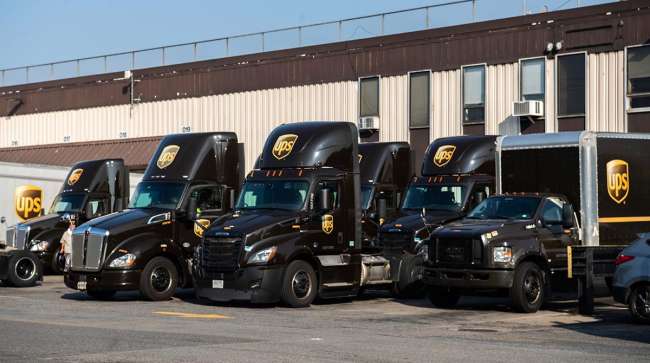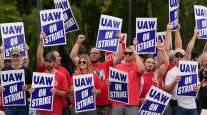Staff Reporter
UPS Lost More Business Than Expected on Strike Threat

[Stay on top of transportation news: Get TTNews in your inbox.]
Profits at UPS Inc. fell year-over-year in the second quarter as the parcel carrier lost more business to rivals than expected due to uncertainty surrounding high-profile labor negotiations with the Teamsters union, executives said Aug. 8.
UPS reported net income of $2.08 billion in the three months that ended June 30, compared with a profit of $2.19 billion in the same period a year earlier. The company’s diluted earnings per share were $2.42 for the most recent quarter, compared with $2.54 in the year-ago period.
The company cut its full-year 2023 revenue guidance to $93 billion from $97 billion, Chief Financial Officer Brian Newman said, with $1 billion of that due to the strike threat. Of that $1 billion, the impact was a 50-50 split between wages and volume diversions, he added.
The carrier shed 1.2 million packages a day of business to rivals as a result of what CEO Carol Tomé termed the “late and loud” negotiations with the Teamsters union, which represents around 340,000 UPS employees. A tentative deal was reached with the union July 25.
Average daily volume at UPS in the most recent quarter was 17.74 million packages, compared with 19.69 million in the year-ago period, according to a quarterly company presentation.
UPS ranks No. 1 on the Transport Topics Top 100 list of the largest for-hire carriers in North America.
Atlanta-based UPS posted consolidated revenues of $22.1 billion, a 10.9% decrease from the second quarter of 2022’s $24.8 billion.
U.S. domestic package revenue fell 6.9% in the second quarter to $14.396 billion from $15.459 billion in the year-ago period, the company said, adding that the 9.9% decrease in domestic average daily volume was to blame.
The company’s revenue came in below the C-suite’s expectations due to the decrease in volumes caused by the uncertainty around the negotiations, Tomé said during UPS’ earnings call.
UPS expects that by the end of the second half of 2023 the carrier’s average daily volume will be down “midsingle digits” compared with the same point a year earlier, Newman said on the call.
UPS’ domestic operating margin for the second quarter was above executives’ expectations, Tomé said. UPS posted an operating margin for the most recent three months of 11.1%, compared with 11.8% in the year-ago period.
In an effort to mitigate the impact of the talks, the company moved volumes to automated buildings from nonautomated buildings and cut the number of flights it operated, Newman said. He also noted during the call that UPS had reduced its management head count by 2,500 positions in the 12 months through the end of the second quarter.
UPS’ volume throughput at its automated hubs is expected to average 57% in 2023, compared with 53% in 2022, said Tomé, which not only aided the company during the contract negotiations but will also offset some of the wage pressure from the labor deal over the coming year.
The contract was “a win-win-win” for all parties concerned, Tomé said, adding that July’s diversions to rival shippers have not been as great as those in June when seen through the lens of a year-over-year comparison.
UPS is now “laser focused” on winning customers back, the company’s top executive said, and it is “already seeing some volume come back.”
It is “all hands on deck” at UPS to win customers back, Tomé said. The company created a “control tower” similar to those initiated during peak shipping season to deal with all the returning business, she added.
The contract is a win for the U.S. as a country, she said, as UPS moves 6% of all freight, and disruptions to the economy were avoided. The deal was also a win for the company, its shareholders, its people and customers, she said.
Tomé expressed confidence UPS would win back all the lost business, of which she said 1 million were diversions and 200,000 sales that could not be closed as a result of uncertainty surrounding the talks.
Bank of America Securities Research Analyst Ken Hoexter said in a note to investors on Aug. 8 that such “a target was somewhat aggressive given the typical permanency of some diversion.”

Host Michael Freeze clarifies the differences between predictive and preventive maintenance. He gives fresh commentary on everything from how enhanced connectivity boosts your preventive maintenance plans to what predictive possibilities AI can offer your shop. Tune in above or by going to RoadSigns.ttnews.com.
Providing insight into where all the packages ended up, Tomé said a third went to the U.S. Postal Service, a third to the company’s biggest competitor, FedEx Corp., and the rest to regional carriers. Price cuts will not be used to win back the lost business, Tomé said.
Not all the freight will come back, but most will, Stifel Research Director for Transportation Bruce Chan told Transport Topics Aug. 9. Customers were not unhappy with the service UPS was providing, he said.
The parcel sector is much more disciplined than it was several years ago, Chan said, so there is unlikely to be a price war as UPS tries to win back the business it lost because of the Teamsters spat.
UPS has had an eventful few months, he said, during which the company’s management team “has done a good job of blocking and tackling” when battling the challenges they faced.
UPS expects a 60% surge in shipping business for the 2023 peak, Tomé said, adding that this year’s peak was expected to be 21 days. UPS is just starting from a lower level in 2023 as a result of the labor negotiations-related diversions, she added.
UPS rank-and-file members were expected to begin voting on the labor contract on Aug. 3 and conclude by Aug. 22.
Want more news? Listen to today's daily briefing below or go here for more info:




